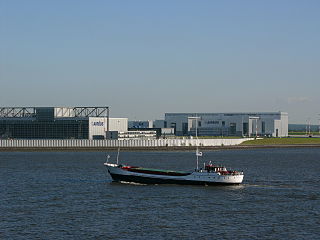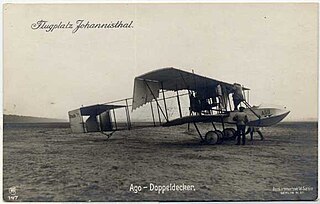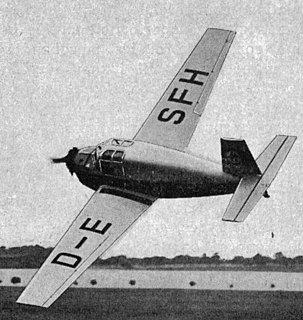 Albert Kesselring in his Siebel Fh 104 | |
| Formerly |
|
|---|---|
| Industry | Aerospace |
| Founded | 1937 |
| Defunct | 1968 |
| Fate | Absorbed by Messerschmitt-Bölkow-Blohm |
| Headquarters | , Germany |
Siebel was a German aircraft manufacturer founded in 1937 in Halle an der Saale. [1]
 Albert Kesselring in his Siebel Fh 104 | |
| Formerly |
|
|---|---|
| Industry | Aerospace |
| Founded | 1937 |
| Defunct | 1968 |
| Fate | Absorbed by Messerschmitt-Bölkow-Blohm |
| Headquarters | , Germany |
Siebel was a German aircraft manufacturer founded in 1937 in Halle an der Saale. [1]
It originated in the Klemm-Flugzeugwerke Halle that had been founded in 1934 as a branch of Leichtflugzeugbau Klemm in Böblingen. Its name changed to Siebel Flugzeugwerke when it was taken over by Friedrich Siebel in December 1937. [2]
After World War II the company was revived as Siebel Flugzeugwerke ATG (SIAT) in West Germany in 1948, with its headquarters in Munich. In 1956, its headquarters were moved to Donauwörth and the company became WMD-Siebelwerke ATG (WMD/SIAT) in 1958 in cooperation with Waggon- und Maschinenbau GmbH Donauwörth (WMD). In 1968 the company was absorbed by Messerschmitt-Bölkow-Blohm after MBB became the major shareholder. [3]
Arado Flugzeugwerke was a German aircraft manufacturer, originally established as the Warnemünde factory of the Flugzeugbau Friedrichshafen firm, that produced land-based military aircraft and seaplanes during the First and Second World Wars.
Bücker-Flugzeugbau GmbH was a German aircraft manufacturer founded in 1932. It was most notable for Its highly regarded sports planes which went on to be used as trainers by the Luftwaffe during World War II.
The Klemm Leichtflugzeugbau GmbH was a German aircraft manufacturer noteworthy for sports and touring planes of the 1930s.

The Siebel Si 204 was a small twin-engined transport and trainer aircraft developed in World War II. It was based on the Fh 104 Hallore. Originally designed in response to an Ministry of Aviation development order for a small civil transport aircraft in 1938, it was eventually produced for the Luftwaffe.

The Argus As 10 was a German-designed and built, air-cooled 90° cylinder bank-angle inverted V8 "low power" aircraft engine, used mainly in training aircraft such as the Arado Ar 66 and Focke-Wulf Fw 56 Stösser and other small short-range reconnaissance and communications aircraft like the Fieseler Fi 156 Storch during, and shortly after World War II. It was first built in 1928.

Airbus Hamburg-Finkenwerder, also known as Hamburg Finkenwerder Airport, is an aircraft manufacturing plant and associated private airport in the Finkenwerder quarter of southwest Hamburg, Germany. The airport is an integral part of the Airbus owned plant, and is exclusively used by them for corporate, freight, test and delivery flights, including the former Airbus A380.

AGO Flugzeugwerke was a German aircraft manufacturing company from 1911 until 1945. The initials AGO had a variety of meanings during the company's lifetime, but in its final version stood for Apparatebau GmbH Oschersleben. At its peak, the company employed around 4,500 people.

The Bücker Bü 180 Student was a 1930s German two-seat sporting/training aircraft built by Bücker Flugzeugbau.
Hansa und Brandenburgische Flugzeugwerke was a German aircraft manufacturing company that operated during World War I. It was created in May 1914 by the purchase of Brandenburgische Flugzeugwerke by Camillo Castiglioni, who relocated the factory from Liebau to Brandenburg an der Havel. Brandenburg's chief designer, Ernst Heinkel was retained by the new enterprise. By Autumn 1915, it had become the largest aircraft manufacturer in Germany, with a capital of 1,500,000 Marks, 1,000 employees, and two more factories - one in Rummelsburg, Berlin, and one in Wandsbek, Hamburg.
The Klemm Kl 105 was a two-seat sport aircraft developed in Germany in 1938. It was a low-wing cantilever monoplane of conventional design with fixed, tailskid undercarriage, and side-by-side seating for two within an enclosed cockpit. Construction throughout was of wood, with the fuselage built using a new semi-monocoque technique which Klemm patented. Plans to produce the design in series were abandoned with the outbreak of the Second World War.

The Siebel Fh 104 Hallore was a small German twin-engined transport, communications and liaison aircraft built by Siebel.

Operation Osoaviakhim was a secret Soviet operation under which more than 2,500 Nazi German specialists (Специалисты; i.e. scientists, engineers and technicians who worked in specialist areas) from companies and institutions relevant to military and economic policy in the Soviet occupation zone of Germany (SBZ) and the Soviet sector of Berlin, as well as around 4,000 more family members, totalling more than 6,000 people, were taken from Nazi Germany for government employment in the Soviet Union. It took place in the early morning hours of October 22, 1946 when MVD and Soviet Army units under the direction of the Soviet Military Administration in Germany (SMAD), headed by Ivan Serov.

The Siebel Si 202 Hummel ("Bumble-bee") was a German light sportsplane of the late 1930s. It was an angular low-wing monoplane, which could be powered by a variety of small engines.
Rumpler-Luftfahrzeugbau GmbH, Rumpler-Werke, usually known simply as Rumpler was a German aircraft and automobile manufacturer founded in Berlin by Austrian engineer Edmund Rumpler in 1909 as Rumpler Luftfahrzeugbau. The firm originally manufactured copies of the Etrich Taube monoplane under the Rumpler Taube trademark, but turned to building reconnaissance biplanes of its own design through the course of the First World War, in addition to a smaller number of fighters and bombers.
The German Air Ministry had a system for aircraft designation which was an attempt by the aviation authorities of the Third Reich to standardize and produce an identifier for each aircraft design's airframe type produced in Germany. It was in use from 1933 to 1945 though many pre-1933 aircraft were included and the system had changes over those years. As well as aircraft of the Luftwaffe, it covered civilian airliners and sport planes, due to the RLM handing all aviation-related matters in the Third Reich, both civilian and military in nature.

The Fieseler Fi 253 Spatz,, was a light civilian aircraft, manufactured by the German company Fieseler in Nazi Germany. Only six units were produced, however, due to the Second World War.

The Gotha Go 150 was a light aircraft designed at the German company Gothaer Waggonfabrik in the late 1930s. It was intended for civilian use, but ended up being used as a military trainer.
Siebel may refer to:

The Volksflugzeug was a grand Nazi-era scheme for the mass-production of a small and simple airplane in the 1930s. It was one of the attempts of the Nazi regime to use consumer technologies as a propaganda tool. Unlike the Volkswagen car, the showpiece of the Nazis’ attempt to appear to work for the good of the average German, as well as the less-known Volksempfänger radio, the Volkskühlschrank refrigerator and the Volksgasmaske gas mask, the Volksflugzeug project was contemplated but never fully realized.
![]() Media related to Siebel aircraft at Wikimedia Commons
Media related to Siebel aircraft at Wikimedia Commons